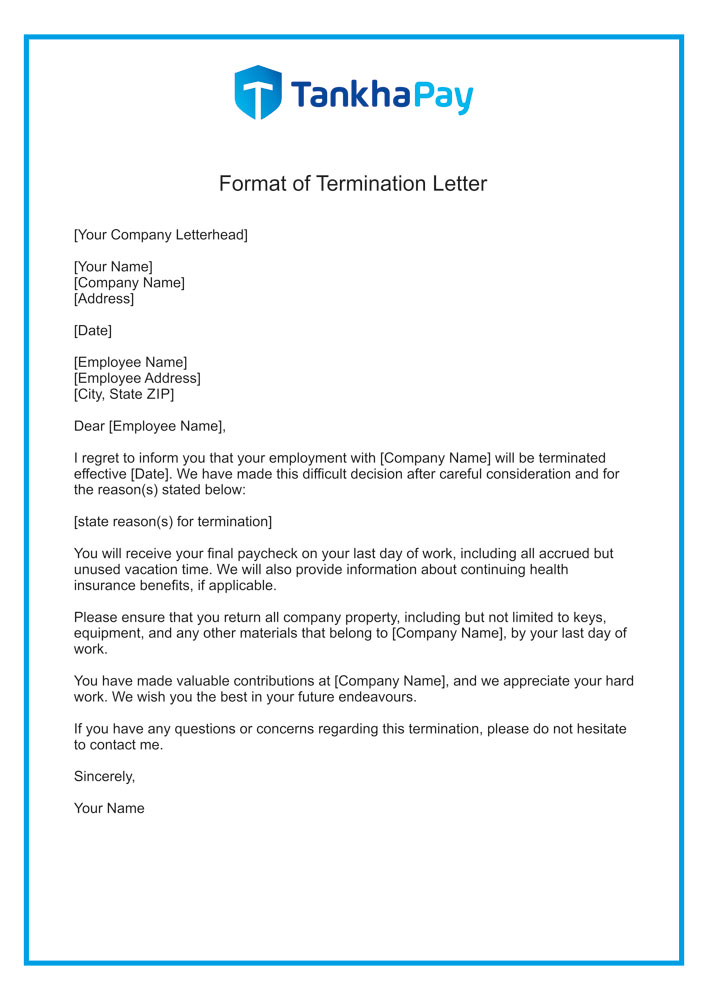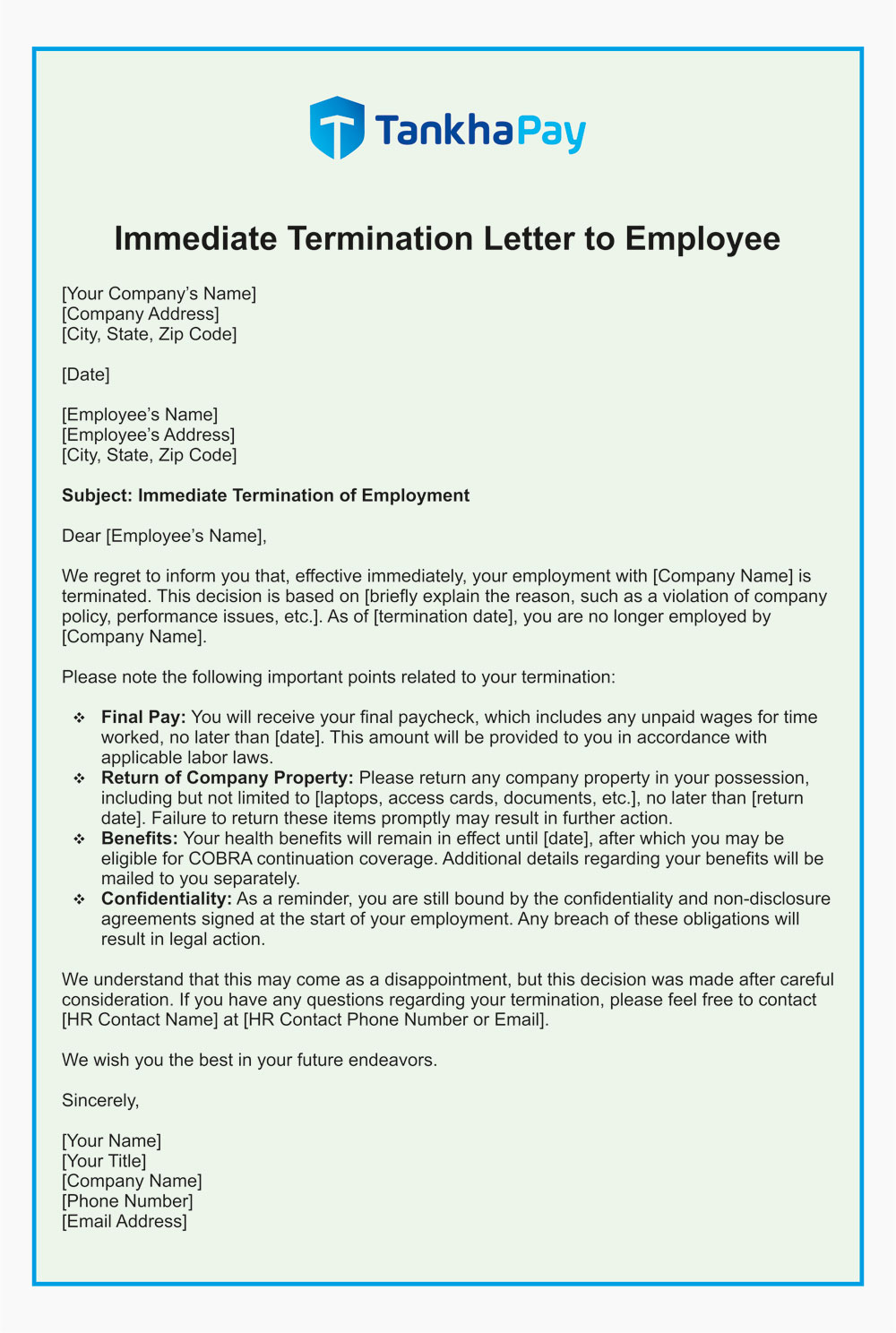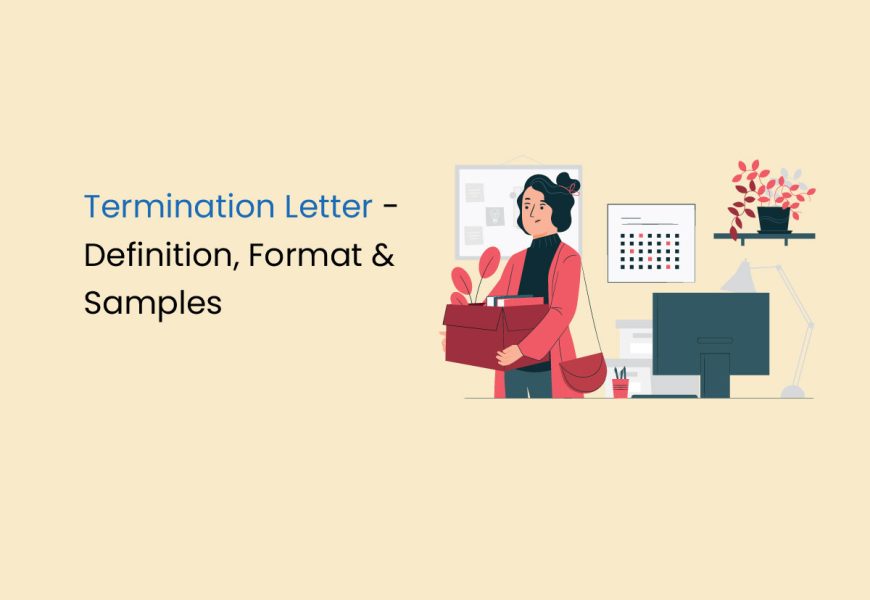A termination letter is a crucial document that forms a part of the termination process. It is used to notify an employee of their termination from the company formally. The letter includes vital information such as the reason for the dismissal, the date of termination, and the final settlement. If you work in the HR department or hold a senior position, you may be responsible for issuing a termination letter to an employee.
Read further to know more about termination letters and how to write them.
What is a Termination Letter?
A termination letter is a written notice issued by an employer to an employee, indicating that their employment contract is being terminated. A termination letter generally includes information like the grounds for dismissal, benefits or severance offered, the date of their final paycheck, and other relevant details.
A termination letter is a document that records an employer’s decision to end an employment relationship. This letter provides important information to the terminated employee regarding the terms of their departure, and it also serves as a legal document that can be used as evidence in any disputes between the employer and the terminated employee.
This document includes the following:
- Introduction: The letter’s introduction should be brief and to the point. State the employee’s name and position, and explain that their employment is being terminated. It is essential to be clear and direct about the letter’s purpose.
- Reason for Termination: The letter should clearly state the termination. It could be due to poor performance, violation of company policies, or other reasons. Whatever the reason, it should be specific and supported by evidence.
- Effective Date of Termination: The effective termination date should be clearly stated in the letter. This is when the employee will no longer work for the company. Calculating the final pay, benefits, and other details is essential based on this date.
- Final Pay and Benefits: Include information on the employee’s final pay and benefits in the letter. This could include payment for unused vacation time, severance pay, and any other benefits to which the employee is entitled. It is essential to be clear and specific about these details to avoid confusion or misunderstandings.
- Company Property: Remind the employee to return any company property, such as keys, equipment, or uniforms, on or before the last day of work. This will help avoid loss or damage to company property and ensure all company property is accounted for.
- Conclusion: End the letter by thanking the employee for their service and wishing them well in their future endeavours. It helps in maintaining a positive relationship with the employees and ensures they leave on good terms.
- Signature and Enclosures: The letter should be signed by the employer or authorised representative of the company. Any enclosures, such as a final paycheck or information on any benefits, should be included with the letter.
Termination Letter Format
You use the following format to write a termination letter:
[Your Name]
[Company Name]
[Address]
[Date]
[Employee Name]
[Employee Address]
[City, State ZIP]
Dear [Employee Name],
I regret to inform you that your employment with [Company Name] will be terminated effective [Date]. We have made this difficult decision after careful consideration and for the reason(s) stated below:
[state reason(s) for termination]
You will receive your final paycheck on your last day of work, including all accrued but unused vacation time. We will also provide information about continuing health insurance benefits, if applicable.
Please ensure that you return all company property, including but not limited to keys, equipment, and any other materials that belong to [Company Name], by your last day of work.
You have made valuable contributions at [Company Name], and we appreciate your hard work. We wish you the best in your future endeavours.
If you have any questions or concerns regarding this termination, please do not hesitate to contact me.
Sincerely,
Your Name

Download Termination Letter in Different Format
| Formats | Files |
|---|---|
Termination Letter Format in Word |
Download |
Termination Letter Format in Pdf |
Download |
Employee Termination Letter Templates
Here are some samples of termination letters:
Template 1: Termination Letter to Employee
[Your Name]
[Company Name]
[Address]
[Date]
[Employee Name]
[Employee Address]
[City, State ZIP]
Dear [Employee Name],
We regret to inform you that your employment with [Company Name] will be terminated effective [Date]. After careful consideration, we have decided to end your employment for the following reasons: [state reason(s) for termination].
Your final paycheck, including any accrued but unused vacation time, will be sent to you on your last day of work. You will also receive information regarding continuing health insurance benefits, if applicable.
Please return all company property, including but not limited to keys, equipment, and any other materials that belong to [Company Name] by your last day of work.
We appreciate your contributions during your time at [Company Name], and we wish you the best in your future endeavours.
Please contact me with any further questions or concerns regarding this termination.
Sincerely,
[Your Name]
Template 2: Termination Letter for Poor Performance
Dear [Employee Name],
We want to thank you for the time and effort you have put into your role as [ ob Title] at [Company Name]. However, we have determined that your performance has not met our expectations, and we regret to inform you that your employment with our firm has been terminated immediately, effective from [Date].
Please ensure that you return all company assets currently in your possession. If you have any remaining unpaid leave, it will be paid to you according to the company’s policy. You will receive the relevant documents via mail at your home address. If you have any questions, don’t hesitate to contact the HR department.
We wish you the best of luck in your future endeavours.
Sincerely,
[Manager Name]
HR Department
Template 3: Immediate Termination Letter to Employee
Dear [Name of Employee],
We are sorry to inform you that your employment with our company will be terminated on [Date]. This decision is final.
Your final paycheck, payment for remaining leaves and severance pay equal to two monthly salaries will be processed and sent to you today.
Your healthcare benefits plan will remain in effect for the next 90 days.
Before the end of the day, please return all company assets that are in your possession. As a reminder, please remember the confidentiality agreement you signed with us.
If there are any further questions or concerns, contact the HR Department.
We wish you all the best in your future endeavours.
Sincerely,
[Name of the Manager]
HR Department

Template 4: Termination Letter Sample of Probationary Employment
[Date]
[Employee Name]
[Employee Address]
[City, State ZIP]
Subject: Termination of Probationary Employment Notice
Dear [Employee Name],
We regret to inform you that your probationary employment with [Your Company Name] is being terminated, effective [Termination Date]. We have determined that you have not met the basic requirements for your position.
Your final paycheck, including payment for any outstanding leave, will be sent within the period required by law. Please ensure that all company property assigned to you is returned upon termination of employment.
We appreciate your efforts during your time at [Your Company Name] and wish you all the best in your future endeavours.
Sincerely,
[Your Name]
Template 5: Termination Email Sample Without Cause
Dear [Name of Employee],
We regretfully inform you of our decision to terminate your employment with our company, effective October 30, 2023. This is a permanent decision.
Please note that you will receive your final paycheck, payment for your remaining leaves, and severance payment of two monthly salaries today. Your healthcare benefits plan will also remain effective for the next 90 days.
Please return any company assets in your possession before the end of the day. Please also remember the confidentiality agreement that you have signed.
If you have any questions or concerns, please don’t hesitate to contact the HR Department.
We wish you the very best in your future endeavours.
Sincerely,
[Name of the Manager]
HR Department
Importance of a Termination Letter
A termination letter is important for the following reasons:
- A termination letter is a formal document that legally proves the termination of an employee’s contract.
- It showcases professionalism and provides a record of the termination if needed.
- It is commonly used to comply with contractual obligations regarding prior notice.
- Even when not explicitly required, a termination letter is a respectful way to end the employment relationship.
- Termination letters fulfil the principles of natural justice by informing the employee of the reason for termination and allowing them a fair hearing if applicable.
- The letter outlines the procedure followed in making the decision.
- It aims to handle the termination amicably, considering the employee’s concerns and providing them with sufficient time and compensation to transition after their unemployment.
- Issuing a termination letter is a generous and respectful approach to dismissal, free from any discrimination towards the employee.
Reasons for Termination
Some grounds for termination are as follows:
- Incompetence: Incompetence refers to an employee’s inability to perform their duties even with assistance. Typically, poor performance is addressed with a series of warnings and interventions before termination.
- Insubordination: Insubordination is when an employee refuses to follow instructions, often accompanied by aggressive or disagreeable language. This behaviour negatively impacts company culture and can make colleagues feel uncomfortable.
- Attendance: Attendance issues, such as being late or taking more days off than allowed, can lead to incomplete work assignments and strained coworker relationships. This behaviour can also negatively affect department morale.
- Theft: Theft is illegal and includes stealing from the company or coworkers. Petty theft, such as taking office supplies home or stealing expensive items like computers or cash, can result in termination and legal action.
- Sharing Confidential Information: Sharing confidential information can result in termination if an employee violates a non-disclosure agreement. Depending on the severity, legal action may also be taken.
- Sexual Harassment: Sexual harassment, in any form, is a severe offence. Companies must take all accusations seriously and conduct investigations. Extreme cases of sexual harassment may also result in legal action.
- Violence: Violence in the workplace, such as damaging company property or physically harming coworkers, is illegal and a zero-tolerance offence. Companies may terminate employees immediately in such cases.
- Threats: Threats, whether verbal or written, are unacceptable in the workplace. Making threats against colleagues or the company is grounds for termination.
- Misconduct: Misconduct is a catch-all phrase that includes various unwanted behaviours such as bullying, criminal activity, lying, fraud, spying for a competitor, and more.
- Substance Abuse: Substance abuse, including using alcohol or illegal drugs on the job, can lead to termination. Some companies may perform random drug tests to ensure employees are not abusing drugs outside of work.
- Damaging Property: Damaging company property intentionally or unintentionally is a fireable offence.
- Falsifying Records: Knowingly recording false statements or facts is illegal and can lead to termination. The specifics of record falsification vary based on the industry and job position.
- Using Company Resources for Personal Benefit: Using company resources for personal benefit, including working on a personal business venture during work hours, can lead to termination.
Things to Remember While Writing a Termination Letter
The things you need to remember while writing a termination letter are as follows:
- Review the Employment Contract: It is essential to review the employment contract to ensure you follow any specific procedures or requirements related to the termination process.
- Identify the Reason for Termination: Determine the specific reason for termination, whether it is because of a violation of company policies, poor performance, or other reasons. Clearly state the reason for termination in the letter.
- Choose the Right Tone: When terminating employment, it is essential to use a professional and respectful tone in the letter. You should be firm and transparent about the decision while also being mindful of its impact on the employee.
- Include all Relevant Information: The termination letter must contain the employee’s name, position, date of termination, reason for termination, and final pay and benefits information.
- Seek Legal Counsel: If there are doubts about the legal requirements for the termination process, it is best to seek legal advice to ensure the termination letter complies with all relevant laws and regulations.
- Review and Edit the Termination Letter: Before terminating an employee, carefully review and edit the letter to ensure it is clear and error-free. Consider seeking feedback from a colleague or supervisor.
- Deliver the Termination Letter: After drafting the termination letter, deliver it either in person or through certified mail to the employee and maintain a copy of the letter for your records.
Without Cause Vs. With Cause Termination Letters
Termination letters are of two types- without cause and with cause. A without-cause termination letter ends employment due to factors related to the company, such as downsizing the workforce or changing the organisational structure. It is not associated with the employee’s performance or behaviour.
On the other hand, a with-cause termination letter dismisses the employee due to issues related to their performance or behaviour. For example, the company may issue a with-cause termination letter if an employee is frequently absent despite repeated warnings.
Frequently Asked Questions
Can I terminate without notice?
Employers must give advance notice of termination plans to employees and the government. Employees terminated without notice or compensation can file a claim with the labour court.
How do I write a termination notice to an employee?
You must include the following details in the termination letter:
- Employee's name, ID number, position, and department.
- Name of the manager or supervisor who is handling the termination.
- Severance package, benefits, and compensation that the employee is entitled to.
- Details of any company property that the employee is expected to return.
- Highlight any legal agreements the employee has signed, including non-disclosure or non-compete clauses.
- Get the letter checked by your legal counsel before sending it.
How do I give notice of termination?
You should provide written notification when terminating an employee and discussing the matter with them.
What are five fair reasons for dismissal?
Misconduct, performance or capability issues, redundancy, breach of statutory restriction, personality clash, significant conflict of interest, or other substantiated reasons that may lead to termination of employment.
What should I include in a termination letter?
You should include the following information:
- The effective termination date should be mentioned.
- Clearly state the reason(s) for termination.
- Explain the compensation (if any) and benefits that will be affected after termination.
- Provide a list of company property that needs to be returned (if applicable).
- Remind the employee of any agreements they have signed (if applicable).
- Share contact details of an HR representative who can be contacted for any queries or assistance.
Do employees need to sign a termination letter?
If an employee does not sign the termination letter, it does not change the fact that they are being terminated. In other words, the termination will still be valid and effective, even if the employee does not provide their signature.
Does termination mean fired?
Involuntary termination is when a company reduces its workforce, fires employees, or conducts layoffs.





















